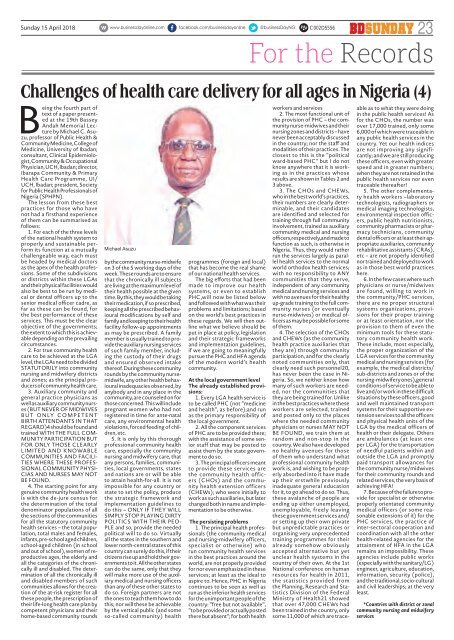BusinessDay 15 April 2018
You also want an ePaper? Increase the reach of your titles
YUMPU automatically turns print PDFs into web optimized ePapers that Google loves.
Sunday <strong>15</strong> <strong>April</strong> <strong>2018</strong><br />
C002D5556<br />
23<br />
For the Records<br />
Challenges of health care delivery for all ages in Nigeria (4)<br />
Being the fourth part of<br />
text of a paper presented<br />
at the 19th Bassey<br />
Andah Memorial Lecture<br />
by Michael C. Asuzu,<br />
professor of Public Health &<br />
Community Medicine, College of<br />
Medicine, University of Ibadan;<br />
consultant, Clinical Epidemiologist,<br />
Community & Occupational<br />
Physician, UCH, Ibadan; director,<br />
Ibarapa Community & Primary<br />
Health Care Programme, UI/<br />
UCH, Ibadan; president, Society<br />
for Public Health Professionals of<br />
Nigeria (SPHPN).<br />
The lesson from these best<br />
practices for those who have<br />
not had a firsthand experience<br />
of them can be summarised as<br />
follows:<br />
1. For each of the three levels<br />
of the national health system to<br />
properly and sustainable perform<br />
its function at a mutually<br />
challengeable way, each must<br />
be headed by medical doctors<br />
as the apex of the health professions.<br />
Some of the subdivisions<br />
or districts within these LGAs<br />
and their physical facilities would<br />
also be best to be run by medical<br />
or dental officers up to the<br />
senior medical officer cadre, as<br />
far as these can be found, for<br />
the best performance of these<br />
services. This must be the clear<br />
objective of the governments;<br />
the extent to which this is achievable<br />
depending on the prevailing<br />
circumstances.<br />
2. For true community health<br />
care to be achieved at the LGA<br />
level, the LGAs need to be divided<br />
STATUTORILY into community<br />
nursing and midwifery districts<br />
and zones; as the principal producers<br />
of community health care.<br />
3. Auxiliary community and<br />
general practice physicians as<br />
well as auxiliary community nurses<br />
(BUT NEVER OF MIDWIVES<br />
BUT ONLY COMPETENT<br />
BIRTH ATTENDANTS IN THAT<br />
REGARD)4 should be found and<br />
trained WITH THE FULL COM-<br />
MUNITY PARTICIPATION BUT<br />
FOR ONLY THOSE CLEARLY<br />
LIMITED AND KNOWABLE<br />
COMMUNITIES AND FACILI-<br />
TIES WHERE THESE PROFES-<br />
SIONAL COMMUNITY PHYSI-<br />
CIAS AND NURSES MAY NOT<br />
BE FOUND.<br />
4. The starting point for any<br />
genuine community health work<br />
is with the de-jure census for<br />
the determination of the total<br />
denominator populations of all<br />
the sections of the communities<br />
for all the statutory community<br />
health services – the total population,<br />
total males and females,<br />
infants, pre-school aged children,<br />
school-aged children (in school<br />
and out of school), women of reproductive<br />
ages, the elderly and<br />
all the categories of the chronically<br />
ill and disabled. The determination<br />
of all the chronically ill<br />
and disabled members of such<br />
communities allows for the creation<br />
of the at-risk register for all<br />
these people, the prescription of<br />
their life-long health care plan by<br />
competent physicians and their<br />
home-based community rounds<br />
Michael Asuzu<br />
by the community nurse-midwife<br />
on 3 of the 5 working days of the<br />
week. These rounds are to ensure<br />
that the chronically ill subjects<br />
are living at the maximum level of<br />
their health possible at the given<br />
time. By this, they would be taking<br />
their medication, if so prescribed,<br />
keeping all the prescribed behavioural<br />
modifications by self and<br />
family and keeping to their health<br />
facility follow-up appointments<br />
as may be prescribed. A family<br />
member is usually trained to provide<br />
the auxiliary nursing services<br />
of such family member, including<br />
the custody of their drugs<br />
and ensured observed intake<br />
thereof. During these community<br />
rounds by the community nursemidwife,<br />
any other health behavioural<br />
inadequacies observed, by<br />
anybody and in any place in the<br />
community, are counseled on for<br />
those concerned. This will include<br />
pregnant women who had not<br />
registered in time for ante-natal<br />
care, any environmental health<br />
violations, forced feeding of children,<br />
etc.<br />
5. It is only by this thorough<br />
professional community health<br />
care, especially the community<br />
nursing and midwifery care, that<br />
any persons, families, communities,<br />
local governments, states<br />
and nations are or will be able<br />
to attain health-for-all. It is not<br />
impossible for any country or<br />
state to set the policy, produce<br />
the strategic framework and<br />
implementation guidelines to<br />
do this – ONLY IF THEY WILL<br />
SIMPLY STOP PLAYING DIRTY<br />
POLITICS WITH THEIR PEO-<br />
PLE and so, provide the needed<br />
political will to do so. Virtually<br />
all the states in the southern and<br />
lower north-central states of this<br />
country can surely do this, if their<br />
citizens rise up and hold their governments<br />
to it. All the other states<br />
can do the same, only that they<br />
will make more use of the auxiliary<br />
medical and nursing officers<br />
than any of these other states to<br />
do so. Foreign partners are not<br />
the ones to teach them how to do<br />
this; nor will these be achievable<br />
by the vertical public (and some<br />
so-called community) health<br />
programmes (foreign and local)<br />
that has become the real shame<br />
of our national health services.<br />
The big efforts that had been<br />
made to improve our health<br />
systems, or even to establish<br />
PHC,will now be listed below<br />
and followed with what was their<br />
problems and limitations; based<br />
on the world’s best practices in<br />
these regards. We will then outline<br />
what we believe should be<br />
put in place at policy, legislation<br />
and their strategic frameworks<br />
and implementation guidelines,<br />
if we are going to meaningfully<br />
pursue the PHC and HFA agenda<br />
of the modern world’s health<br />
community.<br />
At the local government level<br />
The already established provisions:<br />
1. Every LGA health service is<br />
to be called PHC (not “medicine<br />
and health”, as before);and run<br />
as the primary responsibility of<br />
the local government.<br />
2. All the component services<br />
of PHC are to be provided there;<br />
with the assistance of some senior<br />
staff that may be posted to<br />
assist them by the state government<br />
to do so.<br />
3. The principal officers meant<br />
to provide these services are<br />
the community health officers<br />
(CHOs) and the community<br />
health extension officers<br />
(CHEWs); who were initially to<br />
work as such auxiliaries, but later<br />
changed both in name and implementation<br />
to be otherwise.<br />
The persisting problems<br />
1. The principal health professionals<br />
(the community medical<br />
and nursing-midwifery officers,<br />
specialist or otherwise) who<br />
run community health services<br />
in the best practices around the<br />
world, are not properly provided<br />
for nor even emphasized in these<br />
services; at least as the ideal to<br />
aspire to. Hence, PHC in Nigeria<br />
continues to be seen as well as<br />
run as the inferior health services<br />
for the unimportant people of the<br />
country: “free but not available”,<br />
“to be provided or actually posted<br />
there but absent”; for both health<br />
workers and services<br />
2. The most functional unit of<br />
the provision of PHC – the community<br />
nurse-midwives and their<br />
nursing zones and districts – have<br />
never been acceptably discussed<br />
in the country; nor the staff and<br />
modalities of their practices. The<br />
closest to this is the “political<br />
ward-based PHC” but I do not<br />
know anywhere that it is working<br />
as in the practices whose<br />
results are shown in Tables 2 and<br />
3 above.<br />
3. The CHOs and CHEWs,<br />
who in the best world’s practices,<br />
their numbers are clearly determinable,<br />
and their candidates<br />
are identified and selected for<br />
training through full community<br />
involvement, trained as auxiliary<br />
community medical and nursing<br />
officers,respectively,and made to<br />
function as such, is otherwise in<br />
Nigeria. Thus, they would rather<br />
run the services largely as parallel<br />
health services to the normal<br />
world orthodox health services;<br />
with no responsibility to ANY<br />
communities that they serve,<br />
independent of any community<br />
medical and nursing services and<br />
with no avenues for their healthy<br />
up-grade training to the full community<br />
nurses (or eventually<br />
nurse-midwives) or medical officers<br />
as may be possible for some<br />
of them.<br />
4. The selection of the CHOs<br />
and CHEWs (as the community<br />
health practice auxiliaries that<br />
they are) through community<br />
participation, and for the clearly<br />
noted communities only, that<br />
clearly need such personnel20,<br />
has never been the case in Nigeria.<br />
So, we neither know how<br />
many of such workers are needed,<br />
nor the communities that<br />
they are being trained for. Unlike<br />
in the best practices where these<br />
workers are selected, trained<br />
and posted only to the places<br />
where the needed community<br />
physicians or nurses MAY NOT<br />
BE FOUND, we train them at<br />
random and non-stop in the<br />
country. We also have developed<br />
no healthy avenues for those<br />
of them who understand what<br />
professional community health<br />
work is, and wishing to be properly<br />
absorbed into it have made<br />
up their erstwhile previously<br />
inadequate general education<br />
for it, to go ahead to do so. Thus,<br />
these avalanche of people are<br />
ending up either unemployed,<br />
unemployable, freely leaving<br />
these government services and/<br />
or setting up their own private<br />
but unpredictable practices or<br />
organising very unprecedented<br />
training programmes for their<br />
already somehow obviously<br />
accepted alternative but yet<br />
unclear health systems in the<br />
country of their own. At the 1st<br />
National conference on human<br />
resources for health in 2011,<br />
the statistics provided from<br />
the Planning, Research and Statistics<br />
Division of the Federal<br />
Ministry of Health21 showed<br />
that over 47,000 CHEWs had<br />
been trained in the country, only<br />
some 11,000 of which are trace-<br />
able as to what they were doing<br />
in the public health services! As<br />
for the CHOs, the number was<br />
over 17,000 trained, only some<br />
6,000 of which were traceable in<br />
any public health services in the<br />
country. Yet our health indices<br />
are not improving any significantly;<br />
and we are still producing<br />
these officers, even with greater<br />
speed and in greater numbers;<br />
when they are not retained in the<br />
public health services nor even<br />
traceable thereafter!<br />
5. The other complementary<br />
health workers –laboratory<br />
technologists, radiographers or<br />
medical imaging technologists,<br />
environmental inspection officers,<br />
public health nutritionists,<br />
community pharmacists or pharmacy<br />
technicians, community<br />
dental officers or at least their appropriate<br />
auxiliaries, community<br />
rehabilitative assistants (CRAs),<br />
etc – are not properly identified<br />
nor trained and deployed to work<br />
as in those best world practices<br />
here.<br />
6. In the few cases where such<br />
physicians or nurse/midwives<br />
are found, willing to work in<br />
the community/PHC services,<br />
there are no proper structural<br />
systems organizations, provisions<br />
for their proper training<br />
or at least orientation, nor the<br />
provision to them of even the<br />
minimum tools for these statutory<br />
community health work.<br />
These include, most especially,<br />
the proper organization of the<br />
LGA services for the community<br />
medical and nursing services (for<br />
example, the medical districts/<br />
sub-districts and zones or of the<br />
nursing-midwifery ones),general<br />
conditions of service to be able to<br />
live and/or work in these difficult<br />
situations by these officers, good<br />
and well maintained transport<br />
systems for their supportive extension<br />
services to all the officers<br />
and physical health units of the<br />
LGA by the medical officers of<br />
health or their delegate. Others<br />
are ambulances (at least one<br />
per LGA) for the transportation<br />
of needful patients within and<br />
outside the LGA and promptly<br />
paid transport allowances for<br />
the community nurse/midwives<br />
for their community rounds and<br />
related services, the very basis of<br />
achieving HFA!<br />
7. Because of the failure to provide<br />
for specialist or otherwise<br />
properly orientated community<br />
medical officers (or some reasonable<br />
extensions of it) for the<br />
PHC services, the practice of<br />
inter-sectoral cooperation and<br />
coordination with all the other<br />
health-related agencies for the<br />
attainment of HFA in the LGA<br />
remains an impossibility. These<br />
agencies include public works<br />
(especially with the sanitary/LG)<br />
engineer, agriculture, education,<br />
information, security (police),<br />
and the traditional, socio-cultural<br />
and civil leaderships; at the very<br />
least.<br />
*Countries with district or zonal<br />
community nursing and midwifery<br />
services

















